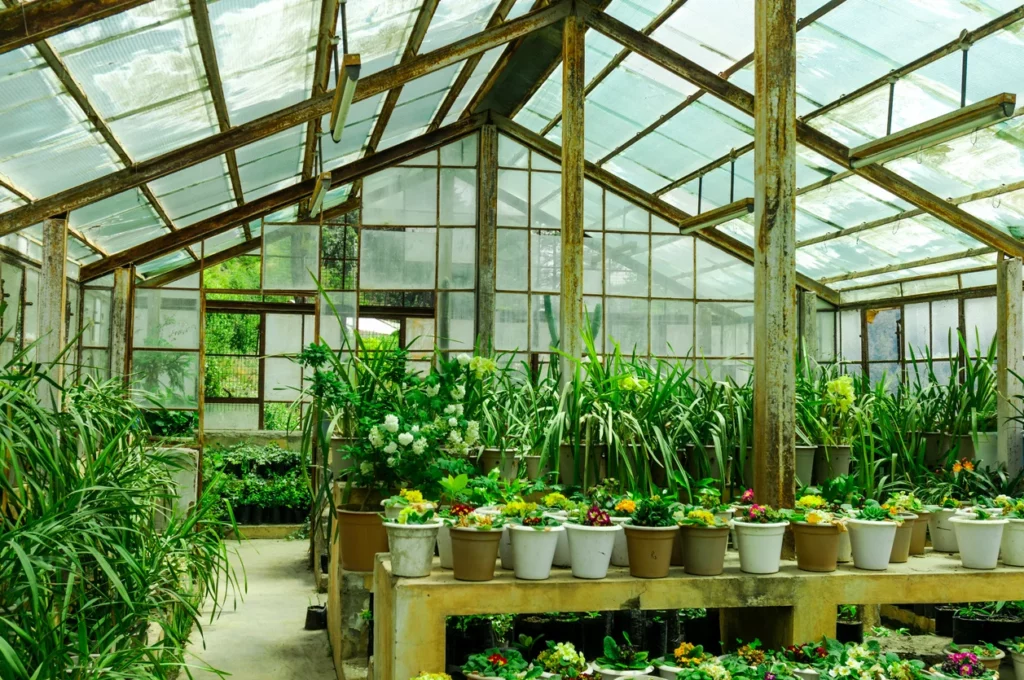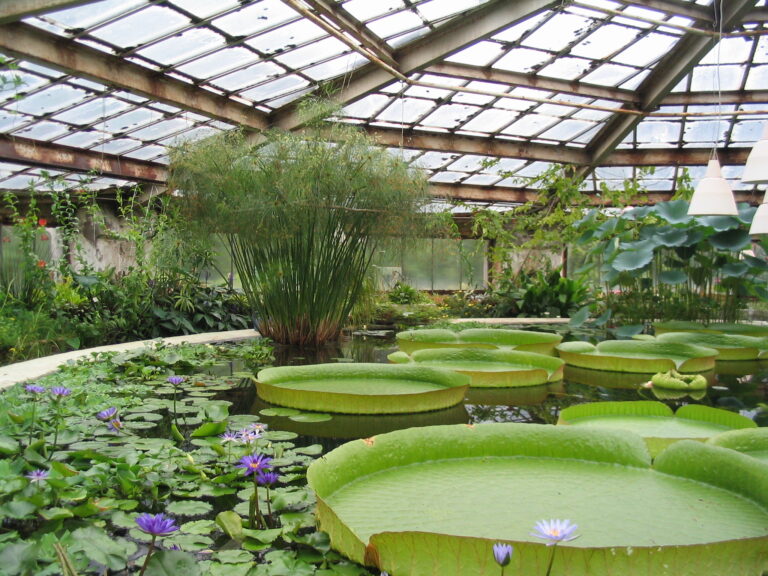As I stood among the lush rows of vibrant, thriving plants inside my climate-controlled greenhouse, I couldn’t help but marvel at the incredible journey that had brought me to this point. It all began with a simple dream of cultivating a year-round oasis for my favorite plants, even in the harshest of weather conditions.
And now, I’m here to guide you on the exciting path of building your very own climate-controlled greenhouse, where you too can transform your gardening ambitions into a reality.
T0o build a climate-controlled greenhouse, follow these steps:
- Select an appropriate location with sunlight and access to water and electricity.
- Design the greenhouse and obtain necessary permits.
- Build the frame and install glazing material.
- Set up ventilation, heating, and cooling systems.
- Control humidity and install supplemental lighting.
- Implement efficient irrigation and environmental monitoring.
- Automate systems and install benches for plants.
- Choose suitable plant varieties and perform regular maintenance.
- Consider security measures and continue learning about greenhouse management.
How Can You Plan Your Climate-Controlled Greenhouse?

Embarking on the journey to create a climate-controlled greenhouse begins with meticulous planning and a clear vision of your horticultural aspirations.
Selecting the Location
Sunlight and Shading Considerations: Analyze the sunlight patterns throughout the year to determine the best orientation for your greenhouse.Assess potential shading sources such as trees, buildings, or hills that might obstruct sunlight.
In addition, consider using shading systems like shade cloth or retractable screens to control excess light during peak summer months.
Accessibility to Utilities (Water, Electricity, etc.): Ensure reliable access to water sources for irrigation and humidity control. Plan for electrical connections to power heating, cooling, and automation systems.
Additionally, alternative energy sources like solar panels or wind turbines reduce operational costs and environmental impact.
Choosing the Greenhouse Design
Types of Greenhouses: Explore various greenhouse designs such as hoop houses, gable-roofed, quonset, or even high tunnels. Understand the advantages and disadvantages of each type in terms of climate control, cost, and suitability for your specific needs.
Size and Layout: Determine the size based on your goals, available space, and budget.
Plan the layout for optimal space utilization, considering walkways, work areas, and plant beds. Consider future expansion possibilities if needed.
Budgeting and Cost Estimation
Create a detailed budget that accounts for all expenses, including construction materials, equipment, climate control systems, and ongoing operational costs. Factor in long-term costs such as maintenance, repairs, and utilities. However, compare costs for different greenhouse designs and materials to make informed decisions.
Obtaining Necessary Permits and Permissions
Research local zoning regulations and building codes to determine if any permits are required for greenhouse construction. Contact relevant authorities and acquire the necessary permits and approvals.
In addition, consult with neighbors if your greenhouse may affect their property, and address any concerns or potential conflicts.
What Materials and Equipment Are Essential for Your Greenhouse?
To construct a successful climate-controlled greenhouse, it’s crucial to carefully select the right materials and equipment, laying the foundation for a flourishing indoor garden paradise.
Greenhouse Frame Materials
Explore options like galvanized steel, aluminum, wood, or PVC for the frame. Additionally, consider the durability, load-bearing capacity, and resistance to corrosion of each material.
Furthermore, select materials that align with your budget and climate conditions.
Glazing Options (Glass, Polycarbonate, etc.)
Compare the pros and cons of different glazing materials, including glass, polycarbonate, and polyethylene. However, consider factors such as insulation properties, light transmission, and cost.
Additionally, choose glazing materials that provide the necessary insulation and light diffusion for your climate control goals.
Heating and Cooling Systems
Evaluate heating options such as gas heaters, electric heaters, or radiant floor heating. Explore cooling methods like natural ventilation, exhaust fans, or evaporative cooling. In addition, select systems that are energy-efficient and capable of maintaining the desired temperature range.
Ventilation and Airflow Solutions
Plan for proper ventilation through roof vents, sidewall vents, or automated louvers. Moreover, ensure adequate airflow to prevent the buildup of humidity and stagnant air.
Implement fans or ventilation systems that can be controlled based on temperature and humidity levels.
Environmental Controls (Thermostats, Humidity Sensors, etc.)
Invest in environmental control systems like thermostats, humidity sensors, and light sensors. Additionally, consider automation and remote monitoring capabilities for precise climate control.
Moreover, integrate these systems to maintain optimal conditions for plant growth while conserving energy.
How to Construct a Climate Controlled Greenhouse?
Building a climate-controlled greenhouse involves a series of strategic steps, from site selection to assembly, to create an ideal environment for year-round cultivation.
Preparing the Foundation
Ensure the foundation is level and properly compacted to provide stability and prevent settling. Consider foundation types like concrete slabs, piers, or perimeter walls based on the greenhouse’s size and weight.
Incorporate drainage systems to manage excess water, preventing water logging around the greenhouse.
Assembling the Greenhouse Frame
Follow manufacturer instructions or architectural plans meticulously to assemble the frame. Check the alignment and integrity of frame components to ensure structural stability. Moreover, secure frame elements with appropriate fasteners and reinforcements to withstand wind and snow loads.
Installing the Glazing Material
Handle glazing materials with care to avoid damage during installation. Seal joints and connections to prevent air leaks and moisture ingress. Moreover, choose appropriate fastening methods such as clips, screws, or glazing bars for your selected material.
Setting up the Heating and Cooling Systems
Ensure heating systems are strategically placed to distribute heat evenly throughout the greenhouse. Furthermore, consider zoning or partitioning to manage heating requirements for different plant sections.
Calibrate thermostats and controls to maintain the desired temperature range without fluctuations.
Implementing Ventilation and Airflow Systems
Design ventilation openings to maximize airflow and prevent hot spots and humidity buildup. Additionally, install exhaust fans with louvers to expel hot air and draw in fresh air. Utilize automated systems to regulate ventilation based on temperature and humidity levels.
What Are the Benefits of Climate Control Systems?

Discover the numerous advantages of implementing climate control systems in your greenhouse, from optimizing plant growth to extending your growing season.
Heating Options (Electric Heaters, Boilers, Radiant Heat, etc.)
Calculate the greenhouse’s heating load based on its size, insulation, and desired temperature. Furthermore, choose heating sources like electric heaters, gas boilers, or radiant floor heating based on energy efficiency, cost, and controllability.
Implement a backup heating source to ensure temperature stability during power outages or equipment failures.
Cooling Methods (Natural Ventilation, Fans, Evaporative Cooling, etc.)
Design natural ventilation systems with roof vents, sidewall openings, or louvered sidewalls to promote passive cooling. Install exhaust fans and circulation fans to enhance airflow and prevent heat buildup.
Moreover, consider evaporative cooling methods, such as misting systems or wet wall pads, to lower temperatures during hot weather.
Humidity Control Strategies
Maintain ideal humidity levels based on the specific needs of your plants. Utilize humidity sensors and misting systems to increase humidity when necessary.
In addition, implement dehumidifiers or proper ventilation to reduce humidity levels in high-humidity climates or during rain events.
Light Control and Supplemental Lighting
Use shading materials like shade cloth or movable screens to control excessive sunlight and prevent plant stress. Moreover, implement supplemental lighting, such as LED or high-intensity discharge (HID) lights, to extend the photoperiod during cloudy days or winter months.
Monitor light levels to ensure plants receive the right amount of illumination for growth.
Automated Climate Control Systems and Their Benefits
Invest in climate control automation for precise and consistent management of temperature, humidity, and light. In addition, set up alarms and notifications to alert you to any deviations from desired conditions.
Optimize energy efficiency by programming systems to respond to weather forecasts and real-time sensor data.
How to Ensure Effective Maintenance and Troubleshooting?
Ensuring the long-term success of your climate-controlled greenhouse involves proactive maintenance and troubleshooting strategies to keep your controlled environment in optimal condition.
Regular Maintenance Tasks
- Develop a maintenance schedule that includes tasks like cleaning, lubricating equipment, and inspecting for wear and tear.
- Regularly check for loose or damaged glazing, leaks, and structural issues.
- Clean and disinfect equipment, surfaces, and tools to prevent the spread of diseases.
Monitoring Temperature and Humidity
- Invest in accurate temperature and humidity monitoring systems.
- Set up alerts to notify you of temperature or humidity deviations outside the desired range.
- Maintain records of environmental data to identify trends and make adjustments.
Pest and Disease Management
- Implement integrated pest management (IPM) strategies to minimize pesticide use.
- Regularly inspect plants for signs of pests or diseases and take prompt action when issues arise.
- Rotate crops, practice good sanitation, and quarantine new plants to prevent infestations.
FAQ’s :
How do you make a climate control greenhouse?
Building a climate-controlled greenhouse involves careful planning, selecting suitable materials, installing heating and cooling systems, and implementing automation for temperature, humidity, and ventilation control.
How to build a greenhouse step by step?
Building a greenhouse step by step entails site preparation, foundation construction, frame assembly, glazing installation, and setting up ventilation and climate control systems.
How to build a heated greenhouse?
To build a heated greenhouse, you need to choose appropriate heating systems like electric heaters, boilers, or radiant heat and integrate them into the greenhouse structure. Insulation is crucial for heat retention.
How do I build a greenhouse?
Building a greenhouse involves selecting a location, designing the structure, acquiring materials, constructing the frame, installing glazing, and setting up climate control systems. It’s a comprehensive process that requires careful planning and execution.
What is the best temperature for a greenhouse?
The best temperature for a greenhouse depends on the types of plants you’re growing. Generally, a range of 70°F to 75°F (21°C to 24°C) during the day and 60°F to 65°F (15°C to 18°C) at night is suitable for many crops.
What is the best cooling system for a greenhouse?
The best cooling system for a greenhouse depends on factors like size, climate, and budget. Options include natural ventilation, exhaust fans, evaporative cooling, and automated climate control systems tailored to your specific needs.
Conclusion :
In concluding my journey through the intricacies of building and managing a climate-controlled greenhouse, I must emphasize the multifaceted nature of this endeavor. From the initial site selection to the meticulous construction process, and the ongoing maintenance, this guide has shed light on the pivotal aspects that culminate in a thriving greenhouse.
As I’ve delved into the nuances of climate control, plant layout, and sustainable practices, it has become evident that a successful greenhouse is a harmonious blend of science, art, and commitment. Personally, this exploration has deepened my appreciation for the delicate balance required to create a flourishing ecosystem under the protection of glass walls.
Moreover, I’ve learned that a greenhouse is not merely a structure but a dynamic, living entity that responds to care, attention, and adaptation.

